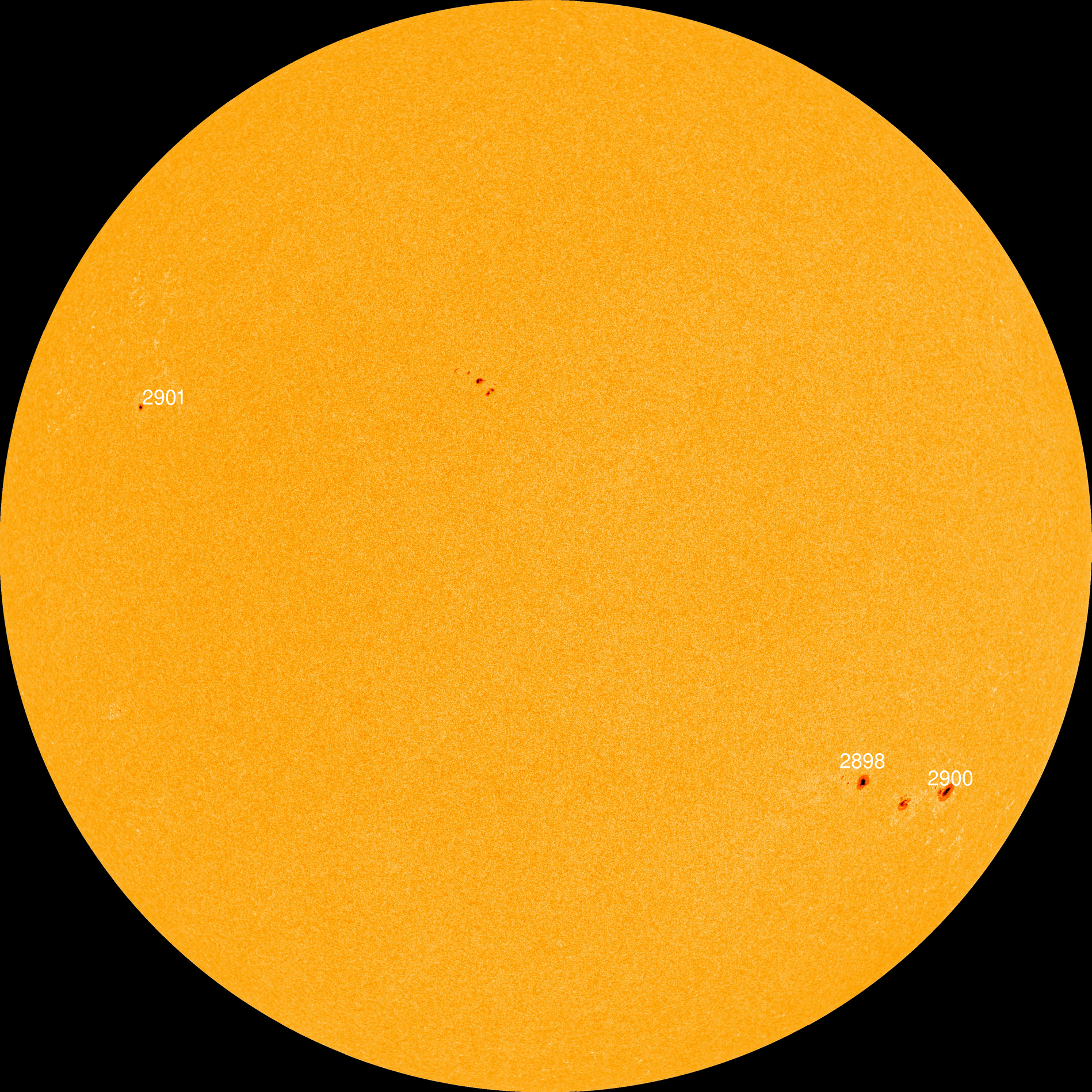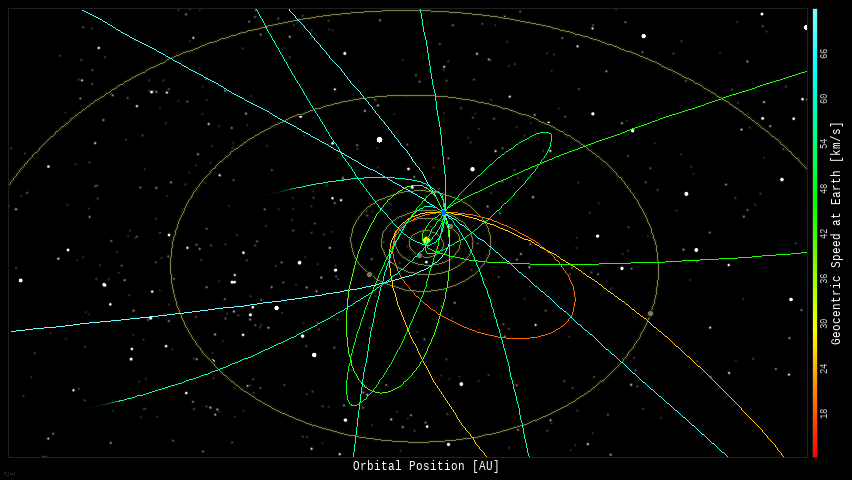Endeavour Space Academy – What are they teaching these kids?
My wife and I held another meeting of our after-school astronomy and space science club – Connie is having the students construct Pop! Rockets. She was using two different types of old film canisters (which the students had never seen before) and Alka-Seltzer® as propellant. I really need to order some model rocket kits for them next!
I asked the students if they’d ever seen a SpaceX launch and landing – they hadn’t… I honestly did say “What are they teaching kids these days? MAN!” I showed them the Falcon Heavy launch and landings, and the “How Not to Land an Orbital Rocket Booster” video.
I discussed the Double Asteroid Redirection Test (DART) mission at length… because asteroids!

As a comparison, I also showed them the animation of comet Tempel 1 being struck by the Deep Impact mission’s impactor.

And I discussed the Parker Solar Probe’s latest perihelion – see the Inner Solar System image below.
Something I found this morning in the latest WGSBN Bulletin: Sigourney Weaver now has an asteroid named after her!
(550525) Sigourneyweaver = 2012 NL
Discovery: 2012-07-12 / T. Kryachko, B. Satovski / Zelenchukskaya Stn / 114
Sigourney Weaver (b. 1949) is a talented actress and selfless nature protector. Her participation in the legendary cycle of Alien films interested a young generation in the possible problems of space exploration and the search for extraterrestrial intelligence.
From: https://www.wgsbn-iau.org/files/Bulletins/V001/WGSBNBull_V001_012.pdf
Also from that same bulletin:

Mars continues to appear low above the east-southeastern horizon before sunrise all week – on Dec. 2nd, a very thin waning crescent Moon appears near Mars.

The planets Jupiter, Saturn and Venus appear in the south-southwestern sky after sunset all week. The planets look pretty much the same as last week – but on Dec. 6th, the waxing crescent Moon will appear near Venus.

The constellations Taurus and Orion rise in the east a few hours after sunset.

The constellation Ursa Major, with the “Big Dipper” asterism, appears low above the northern horizon after sunset all week.


- The Moon is a Waning Crescent – visible low to the east before sunrise.
- The New Moon occurs on Dec. 4th.
- After Dec. 4th, the Moon will be a Waxing Crescent – visible toward the southwest in early evening.

If you click on the Moon image above, or click this link, you will go to NASA’s Moon Phase and Libration, 2021 page – it will show you what the Moon looks like right now. If you click the image on that page, you will download a high-rez TIFF image annotated with the names of prominent features – helpful for logging your lunar observations!
Moon News

The Sun has 2 named spots, and another one is growing near the center of the Sun’s face.

Videos courtesy of NASA/SDO and the AIA, EVE, and HMI science teams.
You can view the Sun in near real-time, in multiple frequencies here: SDO-The Sun Now.
You can create your own time-lapse movies of the Sun here: AIA/HMI Browse Data.
You can browse all the SDO images of the Sun from 2010 to the present here: Browse SDO archive.
Amateur Solar Astrophotography

Solar Corona
Solar wind speed is 353.2 km/sec ▼ with a density of 13.6 protons/cm3 ▲ at 1416 UT.
Click here to see a near real-time animation of the corona and solar wind from the Solar & Heliospheric Observatory (SOHO).
Sun News:
The ESA’s Solar Orbiter completes Earth flyby – with a lot of fanfare about flying through Earth’s space debris fields.

- Near-Earth Objects (NEOs) discovered this month: 290, this year: 2814 (+63), all time: 27,651 (+63)
- Potentially Hazardous Asteroids (PHAs): 2234 (+3 updated 2021-11-30)
- Total Minor Planets discovered (NASA): 1,113,527 (updated 2021-08-17) – not updated for many weeks.
- Total Minor Planets discovered (MPC): 1,143,435 (-28, updated 2021-11-30)
Upcoming Earth-asteroid encounters:
| Asteroid | Date(UT) | Miss Distance | Velocity (km/s) | Diameter (m) |
| 2021 WK1 | 2021-Nov-30 | 2.7 LD | 8 | 21 |
| 2021 WJ1 | 2021-Nov-30 | 4.5 LD | 10.2 | 13 |
| 2021 WH2 | 2021-Nov-30 | 6.2 LD | 7.3 | 9 |
| 2021 WP2 | 2021-Dec-01 | 3.1 LD | 7.3 | 17 |
| 2021 WR | 2021-Dec-01 | 6.8 LD | 8.8 | 29 |
| 2021 WF2 | 2021-Dec-02 | 11.7 LD | 12.6 | 37 |
| 2021 WN2 | 2021-Dec-02 | 5.8 LD | 8.5 | 16 |
| 2021 WZ1 | 2021-Dec-03 | 2 LD | 13 | 16 |
| 2021 UP4 | 2021-Dec-04 | 13.9 LD | 8.3 | 53 |
| 2021 VX7 | 2021-Dec-06 | 14.8 LD | 6.1 | 41 |
| 2021 WE1 | 2021-Dec-06 | 5.6 LD | 9 | 22 |
| 2021 WM2 | 2021-Dec-06 | 8.2 LD | 12.3 | 22 |
| 2021 WL2 | 2021-Dec-06 | 7 LD | 7.5 | 16 |
| 2021 WV1 | 2021-Dec-11 | 1.5 LD | 3 | 7 |
| 4660 | 2021-Dec-11 | 10.3 LD | 6.6 | 759 |
| 2021 WQ1 | 2021-Dec-12 | 7.8 LD | 8.8 | 27 |
| 2021 VW27 | 2021-Dec-13 | 18.7 LD | 8.4 | 42 |
| 2019 XQ1 | 2021-Dec-13 | 14.1 LD | 9.1 | 30 |
| 2021 VT6 | 2021-Dec-14 | 7.7 LD | 6.9 | 51 |
| 2004 YC | 2021-Dec-15 | 18.4 LD | 8.1 | 27 |
| 163899 | 2021-Dec-17 | 14.2 LD | 5.6 | 1093 |
| 2021 LX3 | 2021-Dec-18 | 19.7 LD | 6.5 | 124 |
| 2016 YY10 | 2021-Dec-21 | 11.3 LD | 9.2 | 23 |
| 2017 XQ60 | 2021-Dec-21 | 13.7 LD | 15.7 | 47 |
| 2016 TR54 | 2021-Dec-24 | 16.9 LD | 15.5 | 135 |
| 2018 AH | 2021-Dec-27 | 11.9 LD | 12.7 | 112 |
| 2017 AE3 | 2021-Dec-29 | 9.3 LD | 19.1 | 155 |
| 2014 YE15 | 2022-Jan-06 | 19.3 LD | 6.4 | 8 |
| 2020 AP1 | 2022-Jan-07 | 4.6 LD | 5.7 | 4 |
| 2013 YD48 | 2022-Jan-11 | 14.6 LD | 14.8 | 107 |
| 2021 BA | 2022-Jan-18 | 9.8 LD | 9.1 | 22 |
| 7482 | 2022-Jan-18 | 5.2 LD | 19.6 | 1732 |
| 2018 PN22 | 2022-Jan-21 | 11.4 LD | 2.7 | 11 |
| 2017 XC62 | 2022-Jan-24 | 18.7 LD | 4.3 | 112 |
| 2021 BZ | 2022-Jan-27 | 17.6 LD | 14.6 | 39 |
Asteroid News:

On November 29, 2021, the NASA All Sky Fireball Network reported 11 fireballs!
(10 sporadics, 1 Nov. omega Orionid)

Fireball News:
If you see a bright meteor or a fireball, please REPORT IT to the American Meteor Society and the International Meteor Organization!

Position of the planets & several spacecraft in the inner solar system on November 30th:

Position of the planets in the middle solar system:

Position of the planets in the outer solar system:

Solar System News

See a list of current NASA missions here: https://www.jpl.nasa.gov/missions?mission_status=current

ex·o·plan·et /ˈeksōˌplanət/, noun: a planet orbiting a star other than the Sun.
Data from the NASA Exoplanet Archive
* Confirmed Planets Discovered by TESS refers to the number planets that have been published in the refereed astronomical literature.
* TESS Project Candidates refers to the total number of transit-like events that appear to be astrophysical in origin, including false positives as identified by the TESS Project.
* TESS Project Candidates Yet To Be Confirmed refers to the number of TESS Project Candidates that have not yet been dispositioned as a Confirmed Planet or False Positive.
Exoplanet News:


SpaceWeather.com Realtime Aurora Gallery: https://spaceweathergallery.com/aurora_gallery.html
Latest Aurora Oval Forecast

The Keweenaw Mountain Lodge keeps making me love them, more and more!
- Visit an International Dark Sky Park: https://www.darksky.org/our-work/conservation/idsp/parks/
- If you live in Michigan, visit the Michigan Dark Skies site: https://sites.lsa.umich.edu/darkskies/

Beautiful Universe: Jupiter’s Very Volcanic Moon Io
I showed this image to students during my after-school astronomy and space science club.

Jupiter’s moon Io is a world of active volcanoes. It’s the most volcanically active world in our solar system. Hundreds of volcanoes dot Io’s surface, some spewing lava dozens of miles into the moon’s thin sulfur dioxide atmosphere. The dramatic infrared image above is from the Juno spacecraft, which has been in orbit around Jupiter since July 2016.
The craft’s Jovian Infrared Auroral Mapper (JIRAM) captured Io in infrared, seen here as processed by Roman Tkachenko (@_RomanTkachenko on Twitter), an amateur astronomer and music producer in Kursk, Russia, and one of many citizen scientists who contribute to the Juno mission by processing the spacecraft’s images.
Tkachenko also annotated the image, as shown below:

Software Apps used for this post:
NASA Eyes on the Solar System: an immersive 3D solar system and space mission simulator – free for the PC /MAC.
Stellarium: a free web-based planetarium app. It’s a great tool for planning observing sessions.


